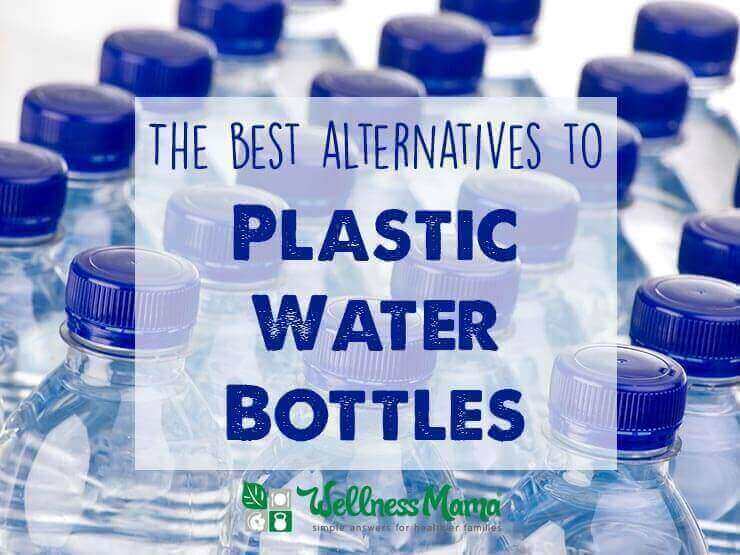Our overuse of plastics has serious consequences both for our health and for our environment.
The Problem of Plastic Water Bottles…
What seems like a harmless plastic water bottle contains hormone disrupting chemicals like BPA and Phthalates. BPA has been shown to cause hormone imbalance in the body and has even been linked to various types of cancers, obesity, miscarriage, infertility and neurological disorders.
Phthalates have been banned in many parts of the world and are especially concerning for men and boys as they have been linked to lower testosterone and male infertility.
The Price of Convenience
As harmful as plastics are to us individually, we are all facing unwanted exposure from worldwide plastic pollution.
Sure, plastic water bottles are inexpensive, disposable and convenient, but they are also terrible for our ecosystem. In fact, many of the negative health effects attributed to the harmful components in plastic may come from our planet’s growing plastic burden.
Many tons of plastic waste are dumped into the ocean each year. The combination of UV light and the salt of the ocean cause these plastics to break down and release BPA, Phthalates, PCBs and DDT into the ocean water. These chemicals are absorbed by small marine life and eventually work their way up the food supply.
In fact, experts now claim that no ocean in the world is free from this plastic pollution and several have said that this is the most dire issue facing our ocean and our planet today. Plastic chemicals were even found under 30 feet of ice in the Antarctic, a place not even inhabited by humans and previously not thought to be contaminated by plastic waste.
Why is this such a problem?
Plastic consumption is still rising at a drastic rate…
Trillions of plastic bags are discarded each year and these bags can take up to a thousand years to degrade. During this time, they are releasing these hormone disrupting chemicals into the ocean, groundwater and soil.
Even now, there is an estimated 46,000 pieces of plastic floating in every square mile of the ocean.
At the rate that plastic is being used and discarded and the length of time that plastic takes to degrade, it seems logical that plastic overuse could become the biggest health and ecological problem of our time. That’s why I like to support brands like Got Bags who understand what we are up against and use plastic from the ocean to make bags and backpacks and other items.
Alternatives to Plastic Water Bottles
Water bottles are not the only source of plastic waste, but they are a major source of plastic exposure. Disposable water bottles can leach their hormone disrupting chemicals right into the water you drink from them. Heat or light exposure can speed up this process, as can the amount of time the water spends in the bottle.
We can all do a lot for our health and the environment by making two simple switches:
- Switching to reusable grocery bags, produce bags, and plastic bags
- Using a reusable, non-plastic water bottle
There are so many great options for reusable water bottles now. I use mine daily for lemon water in the morning, smoothies and herbal tea throughout the day, and water.
Over the last several years, I’ve tried quite a few different plastic-free reusable water bottles and these are my favorites (in order of how much I love them):
1. Hydro Flask
Hydro flask is my favorite reusable water bottle by far. It is not only stainless steel and BPA free, but it is also vacuum sealed and insulated so it is incredible at regulating temperature. I was shocked that it could keep my ice water cold for 24 hours (with ice still floating in it!) and coffee or tea hot for 12 hours.
I have both a wide mouth water bottle and a smaller bottle for hot drinks and I use them both all the time. The only downside? Due to the vacuum sealed insulated layer, these can’t be put in the dishwasher.
2. Lifefactory Glass Bottle
This lifefactory glass bottle is another favorite, but it doesn’t insulate as well as the Hydro Flask and some others. It is dishwasher safe, which is a big plus. I don’t trust the glass as much when I’m with my children, but if I’m on my own, I love this bottle and it doesn’t leak.
3. Klean Kanteen
The original reusable water bottle that I tried and liked enough to get one for everyone on my Christmas list that year. I still love my basic steel Klean Kanteen, though it is not insulated and does not keep drinks hot or cold. Also, if you pour really hot drinks in it, prepare to burn your hand. The upside? You can boil water in it while camping and it can turn iced tea into hot tea if left in the car on a warm day (experience talking).
I still love my Klean, and they are a budget friendly reusable option.
4. Cayman Insulated Water Bottle
The Cayman only comes in one size that I’ve found (about 17 ounces) which makes it a little small for what I prefer in a water bottle. Like the Hydro Flask, it keeps liquids hot or cold for at least 12 hours. It does fit in regular cup holders, which makes it great for taking in the car or on the side of my backpack while traveling and I often prefer this one if I’m on the road.
If you haven’t already, please consider making the switch to one of these alternatives to plastic water bottles (and replace your plastic bags while you are at it!). The convenience of plastic isn’t worth the consequences for our health or the environment.
What kind of water bottle do you use?




Leave a Reply